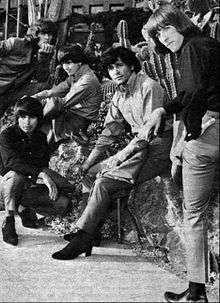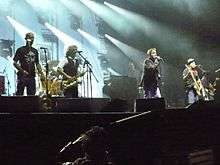Latin rock
| Latin rock | |
|---|---|
| Stylistic origins | |
| Cultural origins | Late 1950s, United States |
| Derivative forms | Latin alternative |
Latin rock is a term to describe a music subgenre consisting in melting traditional sounds and elements of Latin American and Caribbean folk with rock music.[1][2][3][4][5] However, it is widely used in the English-language media to refer any kind of rock music featuring Spanish or Portuguese vocals. This fact lead into a controversy about the scope of the terminology.
Latin rock should not be confused with "Rock music from Latin America"[6][7][8][9] or Rock en español.[10][11][12] It's also closely related to the Latin alternative scene (which combines Latin elements with alternative rock, pop, electronic music, indie or hip hop among others)[13][14][15][16][17] a term oftenly used to refer the same phenomenon.[18]
History
Origins (1950s–1960s)

Rock music originated from African-American rhythm and blues. Also, there was some influence of the traditional Latin music on it. Caribbean rhythms like calypso were remarkable on surf music; and there were some rock and roll songs based on cha-cha-chá or mambo.[19]
Latin Rock (term not yet created) was born in the United States[20] at late 1950s.[21] In 1958 and adaptation of a Mexican folk song called “La bamba” by the chicano rock artist Ritchie Valens.[22] That same year, instrumental rock band The Champs released "Tequila", that incorporates clear Latin sounds (composed by chicano Danny Flores).
During the 1960s, there were more examples of rock artists like Thee Midniters, Question Mark & the Mysterians,[23] Sam the Sham and the Pharaohs[24] or Sir Douglas Quintet[25] that included Latin rhythms on their compositions. Also the rise of the chicano rock in California joined; although not all of them could be considered as early Latin rock artists since many of them lacked the Latin folk influences.[26]
On the other hand, at some Latin American countries, Latin rock started to develop on Peru, Colombia or Argentina, but specially Brazil[27] where Tropicália appeared at mid-1960s[28] with the first releases of Os Mutantes, Gal Costa and Caetano Veloso from 1967 to 1970,[29] a music movement that melt rock music with bossa nova, psychedelia and other Latin elements[30] which has been regarded as the main root of the genre.[31]
"Latin Rock" term born (1970s)
.png)
In 1969, after the release of the debut album by Santana, Latin rock appeared in the US and other parts of the world.[32] They treated to describe the band's music style as a fusion of Latin American and Caribbean rhythms, soul, jazz, funk, blues, psychedelia and rhythm and blues based on rock music.[33][34]
Following Santana, other American bands appeared like Malo, Ocho, Mandrill, El Chicano, Eddie Palmieri's Harlem River Drive, War, Sapo and Azteca at early 1970s popularizing the genre in the USA and the rest of the world since 1970-71.[35]
Latin American counterpart Latin rock bands appeared as it could be seen in Peru with bands like Telegraph Avenue, Traffic Sound, The Mad's, El Polen and specially Black Sugar melting rock with jazz music, Peruvian folk, progressive rock and Latin elements; in Colombia highlighted Siglo Cero, Génesis and La Columna de Fuego; in Argentina Arco Iris; and in Chile, Los Jaivas.
The genre arrived also in Europe, with the Spaniards Barrabás,[36] Dutch Massada and African-British Osibisa.[37]
Meanwhile, Reggae music achieved a great success around the world. This rhythm originated in Jamaica arose during the 1960s, evolving from ska, rocksteady and bluebeat.[38] Since its origins along with rock music and rhythm and blues with Jamaican folk rhythms, the Caribbean and Continental Latin America elements influenced the scene.[39] Nevertheless, Reggae or Ska have never considered as part of the Latin Rock.[40] On the other hand, Disco Music also influenced Latin rock during the 1970s.[41]
Latin rock evolution (1980–Present)
After punk eclosion at late 1970s, the genre also was influenced by many other music styles. Some British punk and new wave acts like The Clash included elements that could be considered as "latin" in "Sandinista!" (1980).[42] Other bands such as Bow Wow Wow, Gang Of Four, The Slits or Special AKA did so.

In Spain, Los Coyotes, Los Mestizos and Radio Futura, that had been emerged as new wave and post-punk acts, finally got influenced by Latin music at mid 1980s.[43] Spain would go on producing some Latin acts like Macaco, Amparanoia or Jarabe de Palo.
In France, bands like Les Negresses Vertes played a fusion of rock with World music including Latin elements. But Manu Chao was the major success of the Latin rock in France with the band Mano Negra (also as a solo artist) with a style that would be known later as Latin alternative. A mix of rock, with Latin elements, Arabic music, punk, rap, flamenco, ska and reggae.[44]
In the US during this period bands like David Byrne (ex-leader of Talking Heads), Peter Gabriel, Paul Simon, Willy Deville, Los Lobos, El Vez, Red Hot Chili Peppers, and Rage Against The Machine appeared, developing some of these "mixing" sounds (specially in Latin folk sounds)
The genre consolidated during the 1990s in Latin America.[45] Many bands appeared such as Maná (Mexico), Caifanes (Mexico), Café Tacuba (Mexico), Aterciopelados (Colombia), Paralamas do Sucesso (Brazil), Bersuit Vergarabat (Argentina), Karamelo Santo (Argentina), Maldita Vecindad (Mexico), Carmina Burana (Argentina), Los Fabulosos Cadillacs (Argentina), Los Tres (Chile), Octavia (Bolivia), Karnak (Brazil), Chancho en Piedra (Chile), Julieta Venegas (Mexico) and Los Rabanes (Panama), that incorported Latin folk rhythms on their compositions (especially Caifanes and Los Fabulosos Cadillacs).
Controversy about the term

At late 1990s, the rising population of "Latinos" in the US[46](term popularized since the 1960s due to the wrong and confusing use of "Spanish" term and the more proper but unpopular term "Hispanic")[47] lead music industry to create the Latin Academy of Recording Arts & Sciences as a sub-department of National Academy of Recording Arts and Sciences. Also in 2000 the Latin Grammy Awards were created. Thus, a great part of the English media started to refer any kind of music featuring Spanish vocals as "Latin music".[48]
This term achieved a great success in some Latin American countries, where some of their regional press started to use the new terminology.[49] This phenomenon spread the use of the "latin rock" term with a completely different meaning of the original one.[50] This lead into a controversy and confusion in the population.
See also
References
- ↑ "Latin Rock". Allmusic.com.
- ↑ "Latin Rock definition". Imusicdictionary.
- ↑ Heatley, Michael (2007). Rock & Pop. La historia completa: Un recorrido exhaustivo a través de cinco décadas de rock y pop. (in Spanish). Robinbook. ISBN 978-84-96222-85-4.
- ↑ Finn, Larry (2000). Beyond the Backbeat: From Rock and Funk to Jazz and Latin. Berklee Press Publication.
- ↑ Leng, Simon (2002). Santana. Cátedra (colección Pop-Rock). ISBN 978-84-376-1947-7.
- ↑ Varios autores (2000). Diccionario del Rock Latino (in Spanish). Iberautor Promociones Culturales-Zona de trabajos. ISBN 978-84-8048-408-4.
- ↑ Varios autores (Coordinado por Diego A. Manrique) (1987). Historia de la música Rock (in Spanish). El País.
- ↑ Avant-Mier, Roberto (2010). Rock the Nation: Latin/o Identities and the Latin Rock Diaspora. Continuum Publishing Corporation.
- ↑ Grijalba, Silvia (2000). Santana - El nuevo iluminado (in Spanish). La Máscara. ISBN 978-84-7974-426-7.
- ↑ De Limongi, Toni (1999). Los fabulosos cadillacs. los calaveras del rock latino (in Spanish). La Máscara. ISBN 978-84-7974-361-1.
- ↑ McCarthy, Jim (2005). Voices of Latin Rock: The People and Events That Created This Sound. Hal Leonard Corporation.
- ↑ Finn, Larry (2000). Beyond the Backbeat: From Rock and Funk to Jazz and Latin. Berklee Press Publication.
- ↑ Jiménez, Willi (April 2012). "Alterlatino". Zona de trabajos (revista) (in Spanish).
- ↑ Scaramuzzino, Rubén (2008). "Algo así como la Biblia de la Cultura Latina". Zona de trabajos (in Spanish) (53).
- ↑ Pareles, Jon (10 July 2009). "Latin Alternative Music's Movers and Shakers Meet". The New York Times. Retrieved 16 February 2016.
- ↑ "Latin Alternative Music Conference".
- ↑ "PRX Series - The Latin Alternative Radio".
- ↑ Gustavo Arellano. "10 Rock en Español Albums to Listen to Before You Die". ocweekly.com. Retrieved 20 November 2012.
- ↑ Pallan, Michelle H. (2005). Loca Motion: The Travels of Chicana/Latina Popular Culture. NYU Press.
- ↑ David Reyes, Tom Waldman (1998). Land of a Thousand Dances: Chicano rock 'n' roll from Southern California. University of New Mexico Press. ISBN 0-8263-1929-7.
- ↑ Loza, Joseph Steven (1993). Barrio Rhythm: Mexican American music in Los Angeles. University of Illinois Press. ISBN 0-252-06288-4.
- ↑ Mendheim, Beverly (1987). Ritchie Valens: The First Latino Rocker. Bilingual Review Press. ISBN 978-0-916950-79-8.
- ↑ Guerrero, Mark (2008). "Question Mark & the Mysterians: The First Punk Rock Band".
- ↑ "Sam the Sham & the Pharaos". Classic Bands.
- ↑ Huey, Steve (2015). "Sir Douglas Quintet - A Biography". Allmusic.com.
- ↑ David Reyes, Tom Waldman (1998). Land of a Thousand Dances: Chicano rock 'n' roll from Southern California. University of New Mexico Press. ISBN 0-8263-1929-7.
- ↑ Dunn, Christopher (2001). Brutality Garden: Tropicália and the Emergence of a Brazilian Counterculture. Chapel Hill: University of North Carolina Press. ISBN 0-8078-4976-6.
- ↑ "Tropicalia". Allmusic.com.
- ↑ Mei, Giancarlo (2004). Canto Latino: Origine, Evoluzione e Protagonisti della Musica Popolare del Brasile (in Italian). Stampa Alternativa-Nuovi Equilibri.
- ↑ Riccardo Pesanha, Chris McGowan (1998). The Brazilian Sound: Samba, Bossa Nova and the Popular Music of Brazi. Philadelphia: Temple University Press. ISBN 1-56639-545-3.
- ↑ Júnior, Gonçalo (October 2007). "La (in)digestión del Tropicalismo.". Pesquisa-FAPESP.
- ↑ Woog, Adam (2006). Carlos Santana: Legendary Guitarist (The Twentieth Century's Most Influential Hispanics). Lucent Books. ISBN 978-1-59018-972-6.
- ↑ Pasceri, Carlo (2015). Santana: Love, Devotion & Surrender (Storie di Musica Vol.1). Libro digital-Kindle.
- ↑ Leng, Simon. Santana (in Spanish). Cátedra (colección Pop-Rock). ISBN 978-84-376-1947-7.
- ↑ Gillet, Charlie (2008). Historia del Rock. El sonido de la ciudad. Ma Non Troppo Ediciones. ISBN 978-84-96924-39-0.
- ↑ Ordovás, Jesús (1987). Historia de la música Pop española (in Spanish). Alianza editorial. ISBN 978-84-206-0224-0.
- ↑ Aniagolu, Charles (2004). Osibisa - Living In The State Of Happy Vibes And Criss Cross Rhythms. Trafford Publishing. ISBN 1-4120-2106-5.
- ↑ Bradley, Lloyd (2001). This Is Reggae Music: The Story of Jamaica's Music. Grove Press. ISBN 978-0-8021-3828-6.
- ↑ Davis, Stephen (1992). Reggae Bloodlines: In Search Of The Music And Culture Of Jamaica. Da Capo Press. ISBN 978-0-306-80496-0.
- ↑ Barrow, Steve (2001). The Rough Guide to Reggae. Rough Guides. ISBN 978-1-85828-558-0.
- ↑ Alan Jones, Jussi Kantonen (1999). Saturday Night Forever: The Story of Disco. A Capella Books. ISBN 1-55652-411-0.
- ↑ Gendre, Marcos (2015). The Clash: La única banda que importa (in Spanish). Quarentena. ISBN 978-84-16229-11-6.
- ↑ Ordovás, Jesús (1987). Historia de la música Pop española (in Spanish). Alianza editorial. ISBN 978-84-206-0224-0.
- ↑ Robecchi, Alessandro (2002). Manu Chao. Música y Libertad (in Spanish). Random House. ISBN 978-84-397-0856-8.
- ↑ Scaramuzzino, Rubén (2008). "Algo así como la Biblia de la Cultura Latina". Zona de trabajos (in Spanish) (53).
- ↑ Suárez-Orozco, Marcelo (2008). Latinos: Remaking America. University of California Press. ISBN 978-0-520-25827-3.
- ↑ González, Juan (2011). Harvest of Empire: A History of Latinos in America. Penguin Books. ISBN 978-0-14-311928-9.
- ↑ Avant-Mier, Roberto (2010). Rock the Nation: Latin/o Identities and the Latin Rock Diaspora. Continuum Publishing Corporation.
- ↑ Avant-Mier, Roberto (2010). Rock the Nation: Latin/o Identities and the Latin Rock Diaspora. Continuum Publishing Corporation.
- ↑ Varios autores (2000). Diccionario del Rock Latino (in Spanish). Iberautor Promociones Culturales-Zona de trabajos. ISBN 978-84-8048-408-4.
Bibliography
- Avant-Mier, Roberto (2010). Rock the Nation: Latin/o Identities and the Latin Rock Diaspora. United States: Continuum International Publishing Group. ISBN 978-1-4411-6448-3.
External links
- "Gustavo Cerati, el músico que revolucionó el rock latinoamericano". CNN México (in Spanish). 4 September 2014.